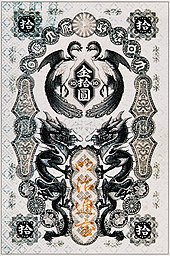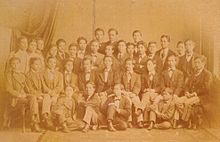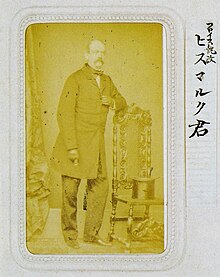Iwakura Mission in Germany
The Japanese Iwakura Mission ( Japanese 岩 倉 使節 団 , Iwakura shisetsudan ), named after its leader, Prince Iwakura Tomomi , visited the German Empire between March and May 1873 as part of its world tour. The focus was on visiting Berlin.
Course of the trip in Germany
We are well informed about the visit to Germany through the report of Kume Kunitake , the diary entries of Kido Takayoshi , one of the prince's deputies, and through reports in the German newspapers. Coming from Holland, the delegation visited the Krupp factory in Essen and then stayed for three weeks in Berlin. After visiting Russia, she traveled by ship from Kiel to Copenhagen and on to Sweden. From there she traveled to Germany a third time and stopped in Hamburg, Frankfurt and Munich. In Frankfurt she visited the C. Naumann printing company, which was just printing the first modern banknotes in Japan.
The visit to Berlin
Since there was nothing to negotiate with the West after the revision of the Unequal Treaties with the West, which had already failed in the USA , the official contacts until the departure on March 28th with mutual invitations had a more social character. The highlight was the reception of the emperor, who had already received the Takenouchi mission as king 11 years earlier . This was followed by invitations to the opening of the session of the Reichstag on March 12th, the Emperor's birthday on March 22nd, to the opera, to the horse race in the hippodrome. The delegation also met the emperor at the opening of the Great Fisheries Exhibition and was impressed by how naturally he was among the people.
The mission used the time for talks with the Japanese living in Berlin, with the ambassador, Samejima Naonobu, with Shinagawa Yajirō , who originally came to Europe as a military observer of the French campaign in 1870/71, and with Aoki Shūzō , who joined Studies in Berlin. Aoki in particular, later ambassador and then foreign minister, knew how to interest the Japanese leadership of the mission in Prussia and its constitution. The representatives of the various ministries collected specialist information and prepared reports.
Some students came to Berlin with the Iwakura mission, mostly from the court nobility ( kuge ). Among them was Mushanokōji Saneyo, who died shortly after the birth of his sons, but left an interest in Germany for them, Kintomo and Saneatsu . Shimizudani Kinnaru (1845-1883) and Bōjō Toshiaya (1847-1906) made careers on their return, the former in the administration of Hokkaido, the latter in the military and as governor of Yamagata Prefecture .
The visit program
The following representative institutions were presented to the mission in Berlin (‡ = no longer or no longer in the form at that time):
- 10.3. Zoological Garden , Tiergarten , Brehmsche Aquarium (Unter den Linden 68, corner of Schadowstraße) ‡
- 14.3. Siemens (Markgrafenstraße 94) ‡, Charité , Kaiserin-Augusta-Hospital (near Invaliden-Friedhof) ‡, Altes Museum with granite bowl in front of it
- 15.3. Königliche Porzellanmanufaktur, KPM , Akademie der Künste ‡ (the state library has stood here since 1914)
- 16.3. Armory , Monbijou Castle ‡
- 17.3. Sodawasserfabrik Soltmann (corner of Alte Jacobstrasse / Hollmannstrasse) ‡, Prussian State Printing House ‡, observatory ‡ (in front of Hallesches Tor)
- 18.3. Franz Kaserne (Pionierstraße, today Blücherstraße) ‡, Dragonerkaserne (Belle-Alliance-Straße, today Mehringdamm: main building used as a tax office), Telegraphenamt ‡, Münze ‡
- 21.3. Moabit prison ‡
- 24.3. Royal Wilhelms-Gymnasium ‡, Friedrich-Wilhelms-University (now Humboldt University main building)
- 25.3. Main depot of the fire brigade at Lindenstrasse 50 ‡, Large fishing exhibition ‡, Borsig ‡
In Potsdam they visited on March 27th:
- New palace
- Sanssouci Palace and picture gallery
- Belvedere on the Pfingstberg
- Marble palace
- Babelsberg Castle
During a visit to the armory, the Japanese are told that the huge lion in the inner courtyard was taken from the Danes in 1864, who placed it in Flensburg after the victory in the Battle of Idstedt in 1850. Kume remembers that there is a lion on the Waterloo monument that the English had taken from the French. And he also knows that Napoleon had the Quadriga transported away from the Brandenburg Gate. He comes to the conclusion, slightly ironically, that in Europe the wars are about the mutual taking away of lions.
A speech by Bismarck
After visiting the mission in the hotel the day before, Bismarck gave the mission a meal in his residence. He gave a speech that Kume reproduces in his book. It can also be found as A New Speech by Bismarck, but this is a translation from Japanese, initially printed in a newspaper on the occasion of Itō Hirobumi's visit to Berlin in 1901. In this speech, Bismarck stated that the introduction of international law is currently being discussed, but that this would not help weak countries to enforce their rights. Japan must therefore try to become strong. He wished Japan every success in modernizing the country and emphasized that Germany did not intend - in express contrast to England and France - to take part in the race for colonies. (Bismarck could not quite keep this promise at the end of his service.)
Final remark
Kume dedicated ten chapters to Germany in his work, despite the relatively short visit duration of only one month. He not only describes the places visited, but also dedicates chapters or pages in his work to all four kingdoms, the duchies and principalities and the three city republics. Kume, highly educated, describes the West, Germany from a Far Eastern distance. This view from the outside is a remarkable addition to the German historical awareness.
For the Japanese side, the visit to Germany was important because they saw this country in a similar situation to their own. Just as Germany - only recently united - wanted to catch up with the economically and technically superior countries of England and France and tried to find its place between the established great powers, so Japan had to find its place in the western dominated world.
What cannot be overlooked with Kume is that, although he recognized western and German technology, he saw Japan at least on a social level. Kume also noticed that - at least in Germany - the state was trying to suppress the influence of the church, that German society itself began to question religion, in a movement that Kume characterized with the German word moral philosophy .
The visit had a direct impact on the constitutional discussion at home. The decision to take over the German university education in medicine had already been made before the trip, in other areas the German influence only had an impact in the years afterwards.
Individual evidence
- ↑ Illustration from the popular geography book: Uchida Masao (ed.): Yochi shiryaku, 1876. The leap in quality at Kume is obvious.
- ↑ According to information from the Kume Museum Tokyo, hardly any original documents on Kume's book have survived.
- ↑ The Bismarck photo and the photo of the Japanese students can be found in the font of the Kasumi Kaikan (Club of the Japanese Nobility) given below.
- ↑ Bismarck. The collected works, Volume 8. Conversations, pp. 64–65.
- ↑ Citizens' Journal No. 1 of January 1, 1902. A Han-Nama is given as the author . This is likely to be the good English-speaking member of the Hatakeyama Yoshinari Mission .
Remarks
- ↑ On that day, in distant Tokyo, German scholars and merchants, supported by the German Embassy, founded the German Society for Natural History and Ethnology of East Asia , or OAG for short. This foreign company is still active to this day.
- ↑ The beginning of the report on education in Germany is shown, here, 乙 國 written.
- ↑ For the further fate of the lion see Flensburg lion .
- ↑ From the Japanese side the five-volume edition was sent to the envoy Karl von Eisendecher , to the former envoy Max von Brandt , to the companions Colonel Charles von Wright, Lieutenant Colonel Johann Roerdansz in Berlin, to Hofrat Albert Kanski and to Krupp in Essen.
- ↑ The USA and England received 20 chapters each, France (which one stayed in much longer than in Germany) also ten, all other countries - including the great powers Austria and Russia - fewer
swell
- Kume Kunitake: Bei-Ō kairan jikki ( 米歐 回 覧 実 記 ) Shuko shobo 1975 (facsimile reprint of the original five-volume edition from 1878).
- Riji kōtei ( 理事 功 程 ) 1875 (official reports from the relevant delegation members, National Archives of Japan, Tokyo).
- Tanaka Akira (Ed.): Bei-Ō kairan jikki . Iwanami Bunko 1977–82 (5 volumes, original text in modernized written form, annotated).
- Kido, Takayoshi (1983): The Diary of Kido Takayoshi (Sidney DeVere Brown and Akiko Hirota, translator), Vol. II (1871-1874). Tokyo: University of Tokyo Press.
literature
- Peter Pantzer (Translator & Ed.): The Iwakura Mission . Iudicium-Verlag 2002. ISBN 3-89129-746-7 (translation of the Kume texts on Germany, Austria and Switzerland, additional material).
- The Iwakura Embassy 1871-73 . Curzon-Press 2002. ISBN 0-7007-1712-9 (complete translation in 5 volumes).
- Germany, in: I. Nish (Ed.): The Iwakura Mission to America and Europe: A New Assessment. Routledge / Curzon, 1998. ISBN 1-873410-84-0 .
- Kasumi Kaikan (Ed.): Uchinaru kaikoku ("Inner Opening of the Country"), 1993.
- Baedeker's Berlin u. Potsdam . Facsimile print 1987 of the original edition from 1878, ISBN 3-87954-105-1 .















